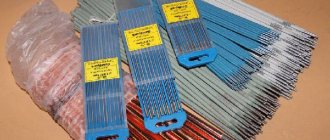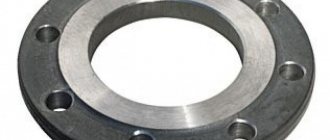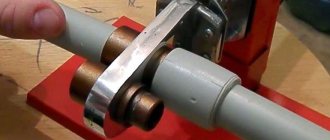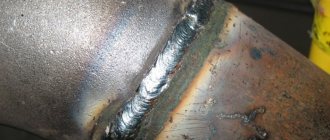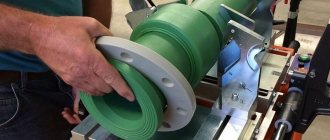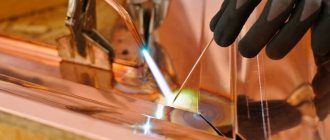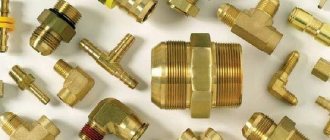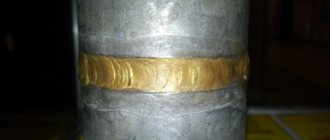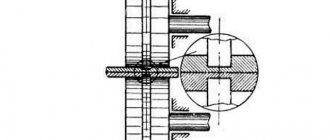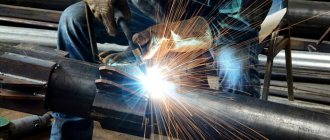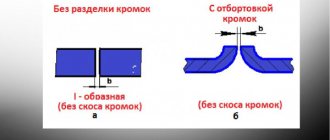Welding polyethylene pipes is one of the most popular methods of connecting them. When welding, a permanent connection is formed, characterized by high tightness and able to withstand significant loads.
Of course, not all techniques for working with a material such as polyethylene can be mastered on your own, so later in the article I will provide an overview of the main technologies and focus on a detailed description of welding algorithms most often used in everyday life.
You can weld parts in different ways
Welding methods for joining polyethylene pipes
Pipes made of polymer materials are actively replacing the usual metal when installing or repairing household communications. Pipelines made from polyethylene pipes are used for heating, sewerage, water supply, in centralized construction and in the private sector. Welding a polyethylene pipe is the most reliable connection method, which is used for the construction of communications operating under pressure.
How the parts are connected
Fittings for detachable connections
When laying pipelines using polyethylene parts, the need to connect them invariably arises.
You can do this in two ways:
- Using detachable fittings;
- By welding.
Weld seam in section
The first option is good because no special tools are required to install the pipeline assembly. On the other hand, the price of fittings is quite significant, and the range of such products is limited, so they are usually installed in places where the possibility of disconnecting pipes is simply impossible - i.e. in the inner part of the pipeline.
The welding method is more labor-intensive, since it requires the use of special equipment - resistance welding machines, couplings, soldering irons, etc. On the other hand, its implementation does not require expensive detachable fittings, and the reliability of pipe splicing with this method increases by an order of magnitude.
Connections using welded couplings
In general, if you plan to install a pipeline from polyethylene parts, then you definitely cannot do without mastering the welding method. And even if you do not do the work yourself, but turn to specialists, it is necessary to know the basics of technology - at least for proper control and assessment of the quality of the result.
Features of installation of polyethylene pipes
Installation of polyethylene pipelines is carried out using welding or fittings. Only in one case do the connections become dismountable - when assembled using compression fittings. Their strength is sufficient to withstand the loads of individual water heating, but are not designed for industrial pressure or water hammer of a central water supply.
Welded joints of polyethylene pipes are more durable, but installation requires special equipment and some skills.
Types of connections
The following methods can be used to connect polyethylene pipes:
- Detachable. To perform such joining of HDPE workpieces, you will need steel flanges. The main feature of this joining principle is that the pipeline can be disassembled during operation.
- One-piece. In this case, it will not be possible to disassemble communications. To make such a connection, the workpieces must be welded. To do this, one of the following methods can be used:
- butt welding of polyethylene blanks;
- welding of HDPE products using couplings.
Read also: How to make a conical hole in metal
To assemble pipelines from large-diameter elements, thermoresistive fittings or butt welding are used. When using both methods, a reliable monolithic connection is obtained.
Methods for welding polyethylene pipes
Welded joints on polyethylene pipelines can be obtained in several ways:
- Socket method using fittings.
- Butt welding. Requires special equipment. The method is most used when installing polyethylene pipes with a diameter of more than 110 mm.
- Extruder welding. Convenient to use to change the direction of the pipeline without additional fittings.
- Electric welding using special fittings.
All of the listed methods for welding polyethylene pipes are based on molecular diffusion (mutual penetration, mixing) of the polymer when heated to its melting temperature. Hence the name of the methods – diffusion.
Note! For a high-quality connection, parts from the same manufacturer are required! Only this can guarantee complete identity of the polymers being joined.
Bell method
Socket welding of polyethylene pipes is performed using special connecting fittings.
Welding tools:
- pipe cutter;
- chamfer;
- calibrator;
- welding machine with adjustable heating for polymer materials;
- a set of appropriate nozzles for heating the pipe and fitting.
Note! If work is carried out at sub-zero temperatures, then the heating time of the connected elements is increased by 1-2 seconds from the standard.
Socket welding is performed as follows:
- The pipe is cut into the required segments.
- The edge that is planned to be joined is processed with a chamfer until continuous chips are obtained, equal in length to two circles.
- Calibrate until a perfect circle is obtained.
- Wipe the parts and degrease them.
- Place the welding machine on a stable stand and heat it up. The temperature is controlled using a barcode fitting. If the device is not equipped with such a function, then the heating temperature is set to 210 degrees. When the welder heats up to the set temperature, the indicator on it will light up.
- At the same time, a pipe and a coupling are put on the nozzles of the electric welding machine and heated.
- Remove the heated parts and connect them by physical force.
- Fix motionless until cool.
Note! Socket welding joints for polyethylene materials are used on pipelines with a small diameter and wall thickness up to 5 mm.
This method is not widely used in private construction, as it is expensive and requires special equipment. The connection with press fittings is simpler and reliable enough for individual water supply or heating communications.
Butt welding
Butt joints are carried out for parts whose wall thickness is more than 5 mm. Work is most often carried out on main pipelines. The equipment for such welding is fundamentally different from socket welding.
For butt welding joints you will need the following equipment:
- Centralizer is a device for stationary, coaxial fastening of the connected ends of pipes. Has two fixed and two moving clamps.
- A trimmer is a tool for processing a cut. The prepared sections must be in complete contact with each other. The permissible gap is no more than 0.5 mm; for large diameter pipelines this distance can be increased to 0.7 mm. If the gap during fitting is larger, then the pipes should be processed again.
- Welding machine for end welding. It is a heating plate coated with Teflon.
- A special drive that brings together and connects the melted ends of the pipeline. There are hydraulic or mechanical varieties.
- Reducing liners that counteract the deformation of soft polyethylene pipes.
- Control unit if the process is automated.
Welding is carried out automatically. The operation algorithm is as follows:
- the ends of the pipeline are secured in the centering frame;
- chamfer and clean (the operation is performed simultaneously);
- the connected ends are simultaneously heated with a special welding “mirror”, the depth of material melting is about 2 mm;
- keep under pressure until cool.
As a result of manipulations, a tight connection with the external welded shaft should be obtained.
Note! Departure from technology threatens overheating of the material and the formation of internal influx. This reduces the permeability of the pipeline and is considered a defective operation.
Butt welding is inexpensive (if you have your own equipment) and is widely used when installing centralized highways. For laying individual communications, equipment can be rented.
Extruder welding
Welding using an extruder (a special tool for melting granular polymer) is used in industrial construction for the installation of curved pipelines. This reduces the cost of work because it does not require connecting fittings.
The connection of polyethylene pipes with an extruder schematically looks like this:
- The pipes are cut at the required angle, cleaned of chips and burrs.
- Use a rag to wipe off dirt from the cut site and degrease it with an alcohol-based solution.
- The sections are manually brought together end to end and fixed in the required position by spot welding - they are tacked.
- Carefully weld the seam with an extruder.
Note! The extruder melts the organic polymer, which can result in a rather unsightly appearance. Do not touch soft plastic with your hands. You should let it cool, after which you can clean the resulting seam with a knife and sandpaper.
Welding with electric welding fittings
Installation using electric welded fittings requires the purchase of expensive components. To operate, you will need a special welding machine without a heating segment.
Electric welded fittings are parts for connecting pipes made of polymer materials, inside of which heating elements are mounted to melt the outer part of the pipe and the inner part of the fitting. The result is the fusion of components into one whole. For connection to the welding machine, the part has ready-made contacts.
According to the technology of work, installation of a pipeline using electric welded fittings is the simplest. It is enough to insert the ends of the pipes to be connected into the fitting and connect it to the welding machine. The process of heating and melting the material of the pipe and coupling is automatic. For this purpose, each part has a special barcode with information about the temperature and heating time.
This method of connecting polyethylene pipes has one drawback - its high cost.
Welding instructions
If you chose polyethylene pipes, you acted wisely, but now they still need to be installed correctly. Let's study
Basic rules
Regardless of which technology you choose - electrofusion or butt welding of polyethylene pipes, you must adhere to the following important principles:
- The connected elements must be compatible (both in composition and physical parameters).
- Butt welding of polyethylene pipes can only be done if the parts have the same diameter and equal wall thickness.
- The edges should be thoroughly cleaned and degreased.
- The ends of the structures that are not involved in the connection process must be closed with plugs in order to avoid exposure to cold air, which negatively affects the process.
- During work, it is necessary to minimize the impact of the external environment, namely:
- in hot weather, do not expose the connection area to sunlight;
- in windy weather, create a barrier to gusts of air;
- In cold weather, it is recommended to heat the work area.
- During welding and cooling of the structure, avoid mechanical impact on the system.
Now let’s look in detail at what the technology of butt welding polyethylene pipes is and using the electrofusion method.
Photo fragment of the electrofusion technique: attached heaters
Electrofusion connection
This type of welding, also called thermistor welding, is used for fastening elements of different wall thicknesses and diameters, as well as for installing non-pressure pipelines - drainage installations, gravity sewers, etc.
To connect using this technology, you will need special electric welded fittings. Now remember the order of work.
- Develop a system design.
- Calculate the required number of pipes and other parts.
- Make a purchase.
- Cut the structure into pieces of the length expected by the plan. Make sure that the cut is made smoothly and avoid molten material flowing into the system.
- Prepare and clean parts, including couplings. It would not be superfluous to degrease the surface of the elements using alcohol, applying it to a piece of rag.
- If the surface of the elements is oxidized, remove excess using a special scraper.
- Secure the elements in the positioner, remembering alignment.
- To prevent dust from entering, wrap the connection area with adhesive tape.
- Close the open ends of the structures with plugs.
- Apply voltage to the coupling terminals.
- Wait for the elements to warm up and stick together.
Thermistor welding of polyethylene pipes should be carried out only if the elements being connected are stationary. The structure should remain in the same position until the seam cools completely.
This is what a butt joint setup looks like
Butt welding
The technology and parameters for butt welding of polyethylene pipes are more interesting, since the elements are connected at the molecular level, forming a more durable seam. This method is used for installing elements with a diameter of 50 mm and a wall thickness of 5 mm.
With this method, the edges of the products are heated using a special heating device, and then melted and in this state are joined, forming one whole and a perfect seam.
The procedure for this type of welding up to point No. 7 is identical to the previous connection option (except that couplings are not required for the work).
Table for determining the heating and cooling time of welded elements
And then it differs and follows this “scenario”:
- Insert the ends of the elements into the apparatus so that the heating plate is between them;
- press the edges against the plate and do not change the pressure until the melting process;
- heat the elements, adhering to the standards (the table below for welding polyethylene pipes will help you with this);
- remove the slab and join the ends, applying uniform pressure to them;
- holding the knot, wait for the polyethylene to cool.
Recommendations for high-quality welding
In order to qualitatively weld a polyethylene pipeline, good equipment and skills in working with polymers are not enough. Errors can already occur at the stage of purchasing materials.
For high-quality welding of a polyethylene pipeline, the following rules should be followed:
- Pipes and fittings should be purchased from one manufacturer. It is better if these are factory materials from well-known manufacturers. Discrepancies in the manufacturer are fraught with discrepancies in pipe diameters and heterogeneity of the organic polymer. Despite the fact that polyethylene is produced using the same methods, the material can be heterogeneous even in different batches of the same manufacturer.
- Pipes and fittings from different brands may have different heating times. Overheating of one of the elements will melt the part and make the connection defective.
- Cleanliness during work is very important. If dust, suspended particles, sand or traces of oil elements enter the welding joint, the joint will be unable to bear the load.
- It is imperative to maintain complete immobility of the welded parts until they cool completely.
Proper butt welds
The correct execution of all welding instructions can be assessed by the final appearance of the polyethylene joint. If an incorrect seam is formed and there is a high risk of leakage during further operation, it is better to cut off the joint at the edges and weld a new one.
In a correctly executed seam, the dimensions of the burr bead must correspond to the standard values.
Standard parameters are calculated based on laboratory tests. Compliance with them guarantees high reliability of the seam and long service life of the pipeline
There are additional requirements for roller parameters:
- Symmetrical and uniform around the entire circumference of the joint.
- The displacement of the pipe walls in the radial plane should not be more than 10% of their thickness.
- The color of the rollers must be identical to the color of the pipe.
- The depression between the burrs should not go deeper than the level of the outer surface of the pipes.
And of course, the presence of cracks and pores is completely eliminated.
1. Normal weld. The rollers of the correct seam have rounded sizes and shapes that do not exceed the established standards. 2. Seam with a small flash. A small burr indicates insufficient warm-up time or weak compression of the pipes during settling
3. Rollers with oversized dimensions. An enlarged weld may be the result of excessive temperature of the heating equipment or its malfunction. 4. Radial displacement of the rollers. Radial displacement of pipes sharply reduces the strength of the connection and can lead to its rupture already at the installation stage
The reason for the asymmetry of the rollers along the circumference may be poor-quality preliminary trimming or the location of the trimmer at an angle to the pipe.
Diffusion method of soldering PE pipes
Today, polyethylene still does not have the same authority as metal or metal-plastic, but in fact its strength and performance characteristics are no worse. Modern technologies at the production stage make it possible to make PE pipes of high quality and reliability. The most interesting method of welding them is considered to be diffusion, which does not require the use of special equipment. Even a beginner can perform welding work using this method.
High- and low-density polyethylene (LDPE and HDPE) are one of the most popular polymer thermoplastics that are in high demand when organizing a wide variety of water supply, wastewater, etc. systems. A distinctive feature of the polymer material is that when heated, it softens because the interconnection of the chain of molecules with each other is lost. Freezing, it regains its former strength, as if the transformation had never happened at all. It is this feature that makes polyethylene an ideal material for welding work on it. While softening the two products, they can be connected, which after hardening will lead to the strongest possible bond. A very strong weld will be created between the two pieces.
PE pipes are welded at a relatively low temperature of 270 degrees Celsius, which greatly simplifies the task of selecting equipment and its subsequent use. The operating time is extremely short (a few seconds for each stage) and can only be adjusted by changing the thickness of the pipelines.
Installation methods
The choice of method directly depends on a number of conditions.
It is necessary to determine where the pipeline will be operated:
- in room;
- on open air;
- in the ground.
For one installation of polyethylene pipes, special equipment and a specialist are required, while the other can be done with your own hands.
Butt welding of pipes
When connecting straight sections of large-diameter pipelines, they are often joined by welding together.
The technology of this process requires precise alignment and clean edge processing of the material being joined. For welding, a special apparatus is used, which can be powered from a portable source. Polyethylene is heated in spirals along its entire diameter, and the parts are pressed against each other. The joint turns out smooth, even stronger than the material itself. This method of connecting plastic pipelines is used where the plasticity of a permanent connection is required. However, despite its cheapness and simplicity, such joining is used only for wall thicknesses of 5 mm and above.
Permanent connection
The inability to maintain the connection during operation forces connections such as butt welding and welding with electric couplings.
The second method is used when installing HDPE pipes in hard-to-reach places, where the plasticity of the area does not play a special role.
The method is more expensive. This is caused by the use of special couplings with spirals already built into them. Such couplings have electrodes for supplying voltage to them from an external power source. The ends of the pipes are inserted into the coupling, the applied voltage heats the spirals, and the structure is welded. It would be wrong to think that permanent connections are made only with straight couplings. In these cases, fittings are also used: tees, adapters from one diameter to another, etc.
Plug-in connection
This type of connection requires maintenance during operation.
This is exactly the case when you can install HDPE pipes yourself. Installation is carried out openly on walls indoors or outdoors, placed in special boxes. Laying outdoors without protection is allowed. For example, in summer cottages when organizing drip irrigation of beds. Or use HDPE pipes as pipelines to create connection points for flexible garden hoses. Only the service life in these conditions is reduced. If, if the requirements are met, the pipe will last up to 50 years or more, then in conditions of open installation - 4-5 years.
With fittings
Fittings are elements that allow you to assemble and install pipelines.
They are:
- straight lines, which allow you to connect pipe elements of the same diameter;
- transitional, with their help there is a transition from one diameter to another.
When it is necessary to turn, branch or join pipes during installation, fittings are used: angles, tees, crosses, couplings, plugs, fittings. If frequent disassembly of the system is necessary during operation, the fitting is also indispensable.
By design features we can distinguish:
- compression - a collapsible connection, where the pipe is seated on sealing rings along the inner diameter, and pressed together with a nut along the outer diameter;
- push fittings are a modern, expensive, but also much practical and reliable type of detachable connection, based on the “push” method;
- press fittings are a permanent connection, where the working element is a press sleeve, which is pressed with pliers.
coupling
Couplings for HDPE pipes are one of the fittings. There is a misconception that this is a special type of connection. However, a coupling is an element that is used to join straight sections of a pipeline. Such a joint can be either one-piece - electric couplings, or collapsible - compression couplings. They are used where it is necessary to continue the pipeline further or to repair the damaged section and insert new material.
Which way is better
To this question, the answer is clear - it all depends on where the polyethylene pipes are installed. For private households and administrative premises, it is advisable to use collapsible connections and work with pipes with a diameter of up to 50 mm.
Diffusion Welding Equipment
It was said above that performing this type of robot is quite simple and you don’t need any special tools.
The following devices will be needed:
- Pipe cutter . A special guillotine-type design designed to cut a pipe at a right angle in the right place.
- Calibrator . A mold inserted into a pipe that allows the original diameter to be restored after cutting has been performed.
- Bevel remover . In fact, this is a knife that is used to chamfer the end parts of pipes so that they have a certain shape. When choosing a bevel remover, you need to pay attention to the quality of the tool and the manufacturer.
- Welding machine . A device similar to a soldering iron that creates a high temperature for melting a polymer material (for more details: “Which machine to choose for welding polyethylene pipes - types and rules of use”).
- Nozzles of different calibers . When diffusion technology is used for welding polyethylene pipes, it is simply impossible to do without nozzles that match the diameter of the pipe cross-section. With their help, the required temperature is created in those sections of pipes that must subsequently be joined.
You also need to take care of the availability of measuring instruments and various rags for cleaning the surfaces being treated. To install nozzles on the welding machine tire, you will have to use plumbing wrenches of the appropriate size, and the electrofusion contacts can be adjusted using a screwdriver. The cost of this toolkit is quite low, and most often most of the devices are available in the house as improvised ones.
Pipe connection methods
The formation of a unified pipeline system from individual elements is carried out in several ways. This can be welding propylene pipes by heating, joining with compression fittings, or cold welding.
The simplest way is to connect using pipeline fittings. A crimp wrench is sufficient for this. The disadvantage of this method is the high cost of fittings. It is more reliable to use elements made of stainless steel, copper or brass. These are not cheap parts.
One of the ways to connect plastic parts is gluing using special adhesives. Their use makes it possible to install polypropylene pipelines quickly and at low material costs.
We will tell you in detail about the method of welding polypropylene pipes with your own hands for beginners in the following chapters.
Rules for welding work on PE pipes
When butt welding of PE pipes is carried out, there are three main methods:
Each method has its own technological features, but the welding process in any case must be carried out in compliance with a number of requirements:
- First you need to properly purchase polyethylene pipes. They all must belong to the same batch and manufacturer. The difference between a quality product and a defective product may not be noticeable, so in any case, preference should be given to factory production. Even a millimeter discrepancy in the diameter of two joined pipes can lead to defects in the subsequent operation of the system.
- Also, the use of products produced under identical conditions ensures full compliance of the pipes in terms of chemical composition and thickness. These indicators affect the time of welding work, or more precisely, the heating stage. The discrepancy between two pipes can lead to the fact that one of them melts more, and the second, on the contrary, does not reach the required conditions. In this case, the joining seam will not be strong enough.
- How clean the material is is also very important. Any technology for welding PE pipes requires working with a perfectly clean surface. The finest sand, dust, dirt and other solid particles can lead to the formation of an insufficiently sealed seam.
- It is also important to take into account weather conditions when working outdoors, because increased humidity during precipitation, overheating of elements in the open rays of the sun and hypothermia in the cold can lead to a deterioration in the strength characteristics of the seam.
- Finally, a very important stage of work is the cooling of the created seam. Until the heated polymer cools completely, you need to fix the products relative to each other.
Required equipment and tools
For welding plastic pipes, it is convenient to use sword-shaped soldering irons with removable nozzles. The heating element for pipe welding is a flat platform called an iron, which has holes for attaching heating attachments.
A welding machine for welding plastic pipes must have a temperature regulator and a heating indicator light. In addition to welding equipment, you need tools for cutting workpieces and removing the foil layer. Rolled plastic is cut in any convenient way:
- a pipe cutter similar to wire cutters;
- metal scissors;
- a hacksaw with a narrow blade.
To clean cuts and remove beads, use finely cut files or sandpaper. To cut pipeline elements before welding, you need to prepare a ruler, square, felt-tip pen or marker.
Working with PE pipes using butt technology
This particular method is applicable for pipes with a wall thickness of 0.5 to 5 centimeters. During the work, the end parts of the pipes are heated and connected to each other under high pressure so that the fixation is maximum until the polymers have completely cooled.
The work is performed as follows:
- The butt ends of the pipes are fixed in a special design so that they can subsequently be heated using a welding machine.
- Fixed pipes must be processed using a chamfer knife. It is necessary to level the ends with its help until the excess material no longer interferes with the creation of a perfectly even joint.
- Then a plate is inserted between the products, which also serves as a heating element, which allows you to quickly melt the polymer material.
- When the required material conditions are achieved, the plate is removed from the gap between the ends of the pipes, and they are brought together with a gradual increase in pressure until the fixation is as strong as possible.
As soon as the material has cooled, a very strong and sealed seam will be visible in the form of a ring encircling the new pipeline.
Types of pipes to be welded
The main material, plastic pipes, has its own characteristics and is classified according to a number of characteristics. The first thing that catches your eye is the color. They can be painted green, grey, white or black. Marking in black means that the composition contains special additives that prevent the destruction of the material when exposed to ultraviolet radiation and can be laid directly on the ground. The rest of the colors have no differences associated with coloring and are used indoors or under a layer of soil.
Classification of pipes by purpose:
- for cold water supply (marked with a blue stripe, maximum water temperature 45C).
- for hot water supply (marked with a red stripe, maximum temperature 85C).
- universal (marked with blue and red stripes, the temperature can reach 65 – 75 C, depending on the manufacturer).
Models for hot, cold water supply and universal type have markings that indicate additional performance indicators of the material:
- PN10 – marking of products for cold water used at system pressure up to 1 MPa (not for residential pipelines);
- PN16 – marking applicable to universal pipes and cold water. This material can withstand temperatures up to 65C and pressure 1.6 MPa;
- PN20 – a material with a thickened wall that can withstand pressures up to 2 MPa and temperatures of 85C (welding heating pipes);
- PN25 - pipes reinforced with a reinforcing layer of fiberglass or foil. Withstand pressure up to 2.5 MPa and water temperature 95C.
Differences between plastic pipes
We often hear (from non-specialists) that metal-plastic pipes are easily joined by welding.
So, I would like to say that there is no such thing as welding metal-plastic pipes, if we are talking specifically about installation, there is no such thing at all.
This definition can be applied to the production process, namely to the welding of one of the layers of such a product - an aluminum pipe. It has a thickness of 0.1 to 0.5 mm, and can be joined using butt or overlap welding.
There are two types of connecting elements: The connection of metal-plastic pipes is carried out using special fittings.
- compression fittings,
- press fittings.
The latter are more reliable; the connection is made by crimping the products with a special tool. Compression fittings are tightened with an ordinary wrench. As you can see, these types of fittings for metal-plastic pipes have nothing to do with welding.
All the confusion has started since aluminum-reinforced polypropylene pipes began to enter the market. In order to be able to use plastic pipes in heating systems, as well as hot water supply, we took this step. But unlike metal-plastic, where the aluminum layer is a real pipe, this product uses foil, most often perforated.
Another type of plastic pipes is PVC products. Such pipes have a lower expansion coefficient. But the ambiguity of the qualities of PVC products (in terms of environmental safety) determined their main area of application - sewage. Although it is quite advisable to use large-diameter pipes on main water pipelines.
Installation of PVC pipes is carried out by welding or gluing.
Welding using “socket” technology
Bell is a fairly well-known name for the functional part of a pipe, which implies its expansion at the end. Welding through a socket involves, in addition to heating the edge parts of the products, inserting the smaller of them into the larger one. The socket can be welded onto one of the pipes, or it will be made there at the production stage. A smooth-walled coupling is usually used as a welded socket, and two pipes are welded in it.
In this case, welding work will cost much more than in the previous one. The reason for this price increase is the larger number of seams created and the purchase of a coupling.
The work is performed as follows:
- The pipes are cut square and then straightened to perfection using a bevel knife and sizing tool.
- Then the surfaces are cleaned of any types of contaminants, and a nozzle of the required diameter is attached to the welding machine.
- The soldering iron starts up and warms up to the desired temperature. Then the coupling is put on one nozzle of the appropriate size, and the pipe is inserted into the bowl of the nozzle, naturally of a smaller size. Once the material is softened to optimal conditions, the two elements can be joined.
- Then all that remains is to insert the pipe into the coupling and fix them in this position for 20-30 seconds.
All the following seams are made by analogy.
Welding pipes in awkward places
Sometimes it becomes necessary to weld in an existing pipeline located in hard-to-reach places. Welding is performed with a small-sized hand-held device, with its help the pipe sections are heated several degrees above the required temperature. Next, the connecting elements are heated and quickly joined to the pipe. During this time, her temperature will drop to normal.
Algorithm of electrofusion welding technology
This method assumes that the worker has a simple transformer and the electric coupling itself, in which the heating element is initially installed. The welding process is quite simple: both pipes are connected to the coupling, and electric current is supplied to it.
The work is performed as follows:
- The pipes are prepared in the same way as in all previous methods, starting with cutting at right angles and ending with stripping.
- The pipes are inserted into an electrical coupling and current is supplied to it from the transformer.
- When the connected pipes have cooled down, you can disconnect the wiring, but the coupling will remain as an element integral with the pipeline.
In fact, electrofusion welding of pipes is quite simple, but requires significant financial investments, since the coupling is a disposable product with a rather expensive filling in the form of heating plates.
Welding specifics
The ability to weld polypropylene is due to its plasticity when heated. By heating the parts to a certain depth and connecting them, we obtain a sealed seam at the points of their contact. Welding machines are used for welding. They are easy to use and do not require special skills to operate. They can be used in a living space, ensuring its ventilation.
Polypropylene pipes are suitable for water pipes laid in an open way. They have a beautiful appearance and do not distort the interior of the room. For domestic needs, products with diameters of 20, 25, 32, 40 mm are used. Mainly designed for pumping cold water, the version with reinforced walls is suitable for hot water supply.
They are marked with the PN designation and numbers, which indicates the scope of their operation.
The marking looks like this:
- PN10 are suitable for pumping water at a temperature of 45 0C under a pressure of 10 atm.
- PN16 are used in systems where the liquid temperature is 60 0C and the pressure is 16 atm. This is a cold water supply.
- Pipes of the PN20 brand allow the passage of liquid under a pressure of 20 atm with a temperature of 95 0C. This includes heating and hot water supply, heated floors.
- PN25 - products subjected to pressure of 25 atm and temperature of 95 0C. They are used in hot water and heating supply systems and main pipelines.
Fittings are installed at the point where the polypropylene pipeline turns or branches, since it cannot be bent.
This:
- adapters;
- bends having different angles of rotation;
- couplings with and without thread;
- crosses, tees, plugs;
- taps, valves, clamps.
When choosing fittings, you need to take into account the following characteristics - internal diameter and wall thickness. The values must match the parameters of the connected pipes.
Features of working with low-density polyethylene
Today, HDPE is very popular as a material that acts as a replacement for iron, cast iron or plastic pipes. Its advantage is obvious - it has a long service life. Installation of products made from such material is quite simple, given the wide functionality of modern devices used in welding (more details: “Joint welding of HDPE pipes: types and features of joints”).
It is worth knowing about some nuances so that welding of polyethylene pipelines gives a high-quality and reliable result:
- It all starts with preparing the workplace. To do this, you need to remove everything unnecessary, as well as clean it of dust, debris, etc. Then all the tools used in the work are located in maximum accessibility.
- Each element used in the welding process, be it a pipe or a fitting, must be cleaned of all types of contamination.
- Then the pipes and fittings are connected to each other.
- We must not forget about preparing the edges of the products. All of them must be cut at the desired angle and cleaned of excess material.
Most often, the manufacturer includes operating instructions with their products, which allows you to carefully care for the pipes. In this case, the welded pipeline serves as long as possible and efficiently.
Permanent connections of HDPE pipes
To make a strong and reliable connection of individual pipeline parts, do-it-yourself HDPE pipe welding is used. Typically, one of two possible welding methods is used:
- Butt connection.
- Connection using an electric coupling.
Butt welding
Butt welding of HDPE pipes is used to connect elements with a diameter of 50 mm and above. To perform the work you will need a special butt welding machine.
The connection principle is to heat the ends of the pipes and connect them under pressure. The molten plastic forms a monolithic joint, which is not inferior in strength to a solid pipe.
Let's look at how butt welding of HDPE pipes is carried out. To carry out the process, the ends of the pipes must be rigidly fixed in the clamps of the apparatus. Then a heating plate is brought to the ends.
After the plastic has warmed up to the melting temperature, the heating plate is removed and the pipes are pressed against each other under a certain pressure. After the seam has cooled, the clamps are removed and the pipes are removed from the apparatus. Process Features:
- The described method can be used to connect fittings and pipes of the same diameter.
- The method is suitable for pipes and fittings with a wall thickness of at least five millimeters.
- Diffuse welding can only be carried out if the ambient temperature is not lower than +15;
Welding polymer pipes is an economical process because the HDPE pipe welding machine has low energy consumption compared to the welding machine used for welding steel pipes.
Electrofusion welding method
Connections made using electric couplings allow the construction of pipelines capable of withstanding a pressure of 16 atmospheres. However, if we compare welding HDPE pipes using electric couplings with the method described above, the first option is more expensive.
The fact is that to make each connection, you need special equipment for welding HDPE pipes - an apparatus for electrofusion welding, that is, overhead electrofusions. The process goes like this:
- The ends of the parts to be welded are thoroughly cleaned.
- The coupling is installed with electric heaters at the junction of the parts being welded;
- After fixing the coupling at the joint, voltage is applied to it. As a result, the ends of the pipes and the coupling itself melt, and after cooling, a monolithic connection is formed. The coupling remains on top of the welded pipes.
As a rule, this technology for welding HDPE pipes is used in cases where several connections need to be made. For example, if an additional branch is inserted into an existing pipeline. If you need to weld a large number of joints, then it is more profitable to use butt welding.
Nuances of preliminary preparation for welding work
When talking about how to weld polyethylene pipes at home, you need to take into account not only the rules of use, but also safety precautions when working with welding equipment.
The key to success is the preparatory work:
- Each unit of welding equipment must be thoroughly cleaned and checked for defects that may affect the quality and safety of the work performed.
- All wiring and grounding should be checked for defective or missing insulation.
- Fuel units must be refueled, or old, stagnant fuel must be removed from them and new fuel must be added.
- It is imperative to carry out a test run of the installation to ensure its functionality.
- The oil level in the hydraulic system of the welding machine must be checked and the same actions performed with it as with fuel.
- If the welding machine is mobile, it must be moved freely so that the work can be carried out without hitches and without risk to the operator of the installation.
- The knives of the facing device must be sharpened to perfection so that the process of processing pipes and fittings occurs quickly, and the result is high-quality products.
- Each control and measuring device must be in good working order.
- When working with HDPE, it is necessary to purchase in advance the required quantity of clamps and reducing inserts, the diameter of which must correspond to the cross-section of the pipes.
- Every part exposed to friction should be thoroughly lubricated. However, even when choosing a lubricant mixture, you need to pay attention to the requirements put forward by pipe manufacturers.
By following all the rules and instructions given in the article, you can obtain a high-quality connection for polyethylene pipes. The method of welding a polyethylene pipe must be selected according to the main criteria: ease of implementation and accessibility for the employee from the financial side of the issue. It is best to entrust the work to a specialist who will take responsibility for all stages - from purchasing the necessary materials and equipment to carrying out welding work and putting the system into operation.
Common mistakes
Among the errors that occur during welding, we highlight the most common:
- Insufficient pre-cleaning of parts. This leads to a weakening of the joint.
- Failure to maintain alignment between pipe and fitting. In 1-2 seconds you can correct this flaw; after the joint has hardened, this cannot be done.
- Inconsistency of the material of the welded products. The result is an unreliable and short-lived connection.
- Violation of work technology, non-compliance with temperature and heating time.
You can avoid mistakes if you take into account the recommendations of specialists, comply with the requirements for performing work, and do not violate the technology of the welding process.
Such work is entirely within the capabilities of a technically competent person who can work with his hands.
If you have not done this before, you can invite a plumber to the first stage and take a closer look at his actions.
Methods for joining PE pipes
Polyethylene pipelines are installed in two ways: using fittings and flanges or several types of welding.
The connection requires special fittings (couplings and sockets) and without them. For pipes with a wall thickness less than 4.5 (diameters 50-110 mm), welding using fittings is used; for larger pipes with a thicker wall, butt welding and extruder welding are acceptable.
Diffusion
The diffusion method involves heating the ends to a viscous flow state. The prepared ends of the workpieces are joined and slightly compressed. Movable polymer molecules, under the influence of pressure, move into the parts being connected, mix, freeze in a new position when cooled, form new chemical bonds and ensure reliable adhesion of the pipes to each other.
It is incorrect to single out any welding method as diffusion. In fact, any welding of polyethylene is based on the process of diffusion of heated molecules.
Bell method
Not the most typical way. There are two options for implementation: using socket pipes and couplings. The method itself is reminiscent of welding polypropylene pipelines: the socket or coupling and the workpiece are heated using a soldering iron with a special nozzle. Then the workpiece is inserted into the socket of another pipe or coupling, fixed, pressed and held. Welding time – 20 seconds. If couplings are used, then the second pipe is soldered into the coupling in the same way. The cost of couplings is low; products with a socket are rarely found in stores. The connection is reliable and durable; small diameters can be welded.
Butt welding
This method is applicable to pipes with a wall thickness of more than 4.5–5 mm and a diameter of more than 50 mm.
Before carrying out work, cut off the polyethylene pipe strictly perpendicularly and thoroughly clean the ends. Then fix the pipe in the welding machine and carefully center it. A heater is inserted between the ends of the heating pipes, the pipes are pressed against it and heated until the ends soften. Then the heater is quickly removed, the ends are compressed in such a way that a small annular bead is formed at the junction - a flash. Cool the joint, then remove the machine. The work has its own subtleties; it requires two people.
Extruder welding
Extrusion - welding using a small apparatus from which molten polyethylene is extruded under pressure. Raw materials in the form of rods or granules are loaded into the extruder. Extrusion is used on pressure communications with a wall thickness of more than 6 mm, but it can also be used to patch non-pressure sewer pipelines with a thinner wall. The connection point is heated by a stream of hot air. It is advisable to chamfer the ends.
The quality of the seam is very high. The advantage of the method is that it is possible to weld an already laid polyethylene pipe without dismantling the pipeline.
Electrofusion welding
This is the most reliable, convenient and universal connection method. It can be used even in hard-to-reach places. But, unfortunately, it is also the most expensive - electric welding fittings are not cheap, and a welding machine also costs a lot. Welding with thermistor couplings is used from small to large diameter polyethylene pipelines.
During thermistor welding, polyethylene blanks are cut strictly perpendicular, carefully cleaned of burrs and dust, inserted into the coupling, and centered using special devices. The coupling has a heating element. It is connected to a special welding machine, current is supplied, the element heats up the coupling and the ends of the pipes, and they are welded.
With this type of welding, it is extremely important to keep the joint motionless until it cools completely.
Which way is better
Before choosing the best connection method, it is necessary to determine which one is applicable in a particular case, depending on the diameter of the pipeline.
The most reliable and universal method is welding using thermistor couplings. But couplings, especially large diameters, are expensive, expensive, and a welding machine (but you can rent one). Therefore, such welding is not very common when arranging a private home.
More often they are butt welded or using solder couplings. Butt welding is used on polyethylene pipes with large wall thicknesses; these are usually not used in private homes. Extrusion welding is not yet very widespread, mainly due to the little known nature of the method.
What is needed for welding?
Welding work involves performing high-tech processes that require special equipment, main and auxiliary.
When choosing tools and welding devices, consider the welding method and parameters of HDPE pipes.
Tools and equipment
Working with HDPE requires that all heating elements of the units have non-stick properties. Then they will not have to be cleaned after welding. All devices, as a rule, are equipped with control indicators and thermostats.
Main welding equipment:
- manual welding for socket method;
- butt joint machine;
- mounting parts;
- heating elements;
- clamp - a stand used for fixing them during processing or pressing them tightly against each other.
Almost all units for welding polyethylene are lightweight and easy to use, and their heating elements are easily replaced.
Welding units are used:
- Mechanical;
- Automatic;
- Hydraulic.
The heating elements are round plates coated with a layer of PTFE. They have a temperature and power light, as well as a fuse. Here you can set the temperature using a special regulator.
For welding products with a diameter greater than 400 mm, the following devices are used:
- butt connection;
- socket connection;
- electrofusion connection.
Universal hydraulic units are especially valued. With their help, you can create many welds in the shortest possible time, since the equipment has all the functionality necessary for the work.
Additional hydraulic tools:
- positioners;
- elements for eliminating oxide deposits;
- equipment for chamfer removal;
- files - to separate highways;
- leveling device;
- bends for HDPE.
When welding using any of the above methods, you must use a full set of tools. If you neglect this or that equipment, the connection may turn out to be of insufficient quality, or even completely defective.
Connection fittings
Fittings for welding are elements designed for connecting pipes, including those of different diameters, as well as for creating branches and turns of routes. Fittings can also be used to connect pipes made from different materials.
Overview of fittings for HDPE pipes
These types of elements are:
- Welded and cast. They are connected to pipes using special welding machines that connect the parts end-to-end. They are usually used on turns and bends in highways. As a result, a strong connection is created, equal in strength to solid material. Such fittings are inexpensive, durable, and available in a wide range. After connection, disassembly of the system is not provided. Manufacturers offer fittings - crosses, reducers, tees, elements with different angles of rotation.
- Electric welding fittings. They can connect several pipes at once. They consist of a polyethylene body, inside of which there was a wire heating element. Pipes are inserted into such fittings, which melt under high temperatures and create a reliable, hermetically sealed connection.
There are also compression fittings, but they are not suitable for welding work. These polyethylene parts with seals are needed to create detachable connections without welding. Create an average level of tightness.
HDPE pipes
HDPE - polyethylene pipes manufactured at low pressure, less than 2 MPa. The finished material has a low density, as a result of which its weight is light - this makes installation and connection simpler.
Features of HDPE:
- Elasticity. They are able to stretch, eliminating ruptures due to deformations that can occur at high temperatures or under mechanical stress - for example, under pressure arising from the formation of ice plugs.
- Flexibility. HDPE pipes can be bent without problems, which is extremely important when creating highways with complex configurations.
- Reliability. HDPE is durable and inert with respect to aggressive media, including oil. They don't rust. They absorb water hammer well.
There are several types of such pipes:
- For cold water supply. They have a longitudinal blue stripe. They have smooth internal walls, on which there is no formation of layers of salts and sediment.
- Gas. They have high throughput, have a long service life, and can withstand high pressure. Identification color marking is a yellow longitudinal stripe.
- For heating and hot water supply. They are reinforced with fiberglass and made of polyethylene, which has high tensile strength.
- Corrugated two-layer. These are pipes with sockets that are used for drainage and sewerage. They are very durable, easy to install, and are not afraid of aggressive environments.
Features of working with LDPE and HDPE
These two types of polyethylene differ slightly in their technical characteristics and parameters. The information is summarized in a table.
| Characteristic | PVD (PNP) | HDPE (PVP) |
| Melting point, °C | 103-110 | 125-132 |
| Softening temperature, °C | 100 | 120-125 |
| Rigidity | small | big |
| Flexibility | big | small |
| Fragility | small | more than PVD |
| Strength | average | high |
When welding, it should be taken into account that LDPE requires a lower temperature to melt than HDPE. HDPE has greater strength than LDPE.
Preparing equipment for welding
Different equipment is used for each type of welding. There is no point in purchasing it for a one-time installation of communications using the butt and electric welding method, because the cost of the kit is several thousand dollars. It is better to use the services of third-party companies or rent equipment.
Welding equipment used
Equipment for socket soldering costs between 100-200 dollars, so everyone decides on their own whether to purchase a welding machine.
The standard set of devices for butt welding of polyethylene pipes includes:
- Centralizer . This is a frame with 4 metal pipe clamps, two of which are movable, and two are rigidly fixed to the base.
- Trimmer . It is a separate disk device for precise mechanical cutting of the ends of welded pipes. The device is attached to the guides of the welding machine.
- Heating mirror. It is a round plate coated with Teflon, onto which pipe joints are pressed to melt the PE. Has a built-in thermometer.
- Hydraulic or mechanical drive . A device for regulating the compression force of pipes during heating and subsequent connection.
- Reducing liners . This is a set of replaceable half rings for fixing pipes of various diameters.
- Control block . Included in equipment sets with automation of the welding process.
- electric welding machine;
- pipe cutters;
- stand;
- calibrator and chamfer;
- nozzles for heating the elements being connected.
In fact, a set of equipment is an independent device that performs certain functions at various stages of the welding process. They can be either intended for purely manual welding or for connecting pipes in a fully automatic mode.
To install electrofusion joints, a suitable welding machine with a built-in barcode scanner is used. No additional devices are required for this process.
Butt welding is used advantageously for pipes with a diameter of more than 50 mm, therefore the equipment for it is of considerable size
For socket welding it will be necessary to purchase the following kit:
In addition to the specified equipment, for installing pipes you may also need general household tools: an adjustable wrench, a tape measure, a marker and others.
Preparation for the welding process
An important factor in high-quality welding of HDPE pipelines is their preliminary preparation. The necessary manipulations to form a good weld will be presented in the form of instructions.
Immediately before heating the parts to be soldered, you need to:
After everything, you need to clean the edges of the parts to be joined from chips.
An electric trimmer significantly speeds up the installation process, especially with large volumes of work, but its cost is too high for a one-time job
After carefully preparing polyethylene pipes and fittings for welding, you can be sure that a high-quality seam is half guaranteed.
Do-it-yourself welding of PE pipes
Welding polyethylene pipes at home is not too difficult and can be done with your own hands. The main problem is expensive equipment. In any case, it is worth renting rather than buying.
Before manipulation, it is necessary to cut the workpieces evenly and thoroughly clean and degrease the ends.
Required tools and materials
To weld polyethylene communications you will need pipes and possibly couplings.
List of required equipment:
- Pipe cutter is a device for cutting.
- It’s a good idea to use an electric trimmer to accurately align the ends of the pipes.
- For larger diameters it would be a good idea to use a chamfer.
- Socket welding machine. Structurally, it resembles a soldering machine for polypropylene.
- Corresponding nozzles.
- For end connections, a special centering machine and a heating element are used.
Stages of work
First, the pipes are cut at an angle of 90°, burrs are cleared, dust and chips are removed, and degreasing is carried out. It is more convenient to do this work with an electric trimmer.
Socket (socket) welding technology
Put the desired nozzle on the soldering iron and heat it for the time specified in the instructions. Then heat the coupling and pipe until the polyethylene softens and connect them. They give time for diffusion and polymerization - for about 20 seconds the compound cannot be touched. Then the second workpiece is connected to the coupling in the same way.
Butt connection
The workpieces are installed in the joining machine, fixed and carefully centered. Before soldering, you need to make sure that the longitudinal axes of the workpieces completely coincide. A heating element is inserted between the polyethylene blanks and held until the material softens. The heater is removed, the workpieces are quickly connected, and pressed with force until an annular bead is formed at the seam site. Stand until cooled.
Butt welding is not as simple as it seems at first glance and requires some experience.
Seam quality control
The reliability of the connection depends on the quality of the seam. The height of the burr bead during a butt connection must correspond to the table data.
There should be no cracks, pores or cavities near the rollers. The rollers must be the same around the entire circumference, the same height. The recess in the center should not fall below the surface of the pipes. The parts should not be offset from each other. If you solder a defect, the connection will have to be cut and redone.
Photos of defective butt joints:
We control the quality of the weld seam
When installing welded joints using any of the methods described above, it is very important to correctly assess how high-quality the weld is. It depends on this whether it will be possible to use this section of the pipeline, or whether everything will have to be redone.
Part with two regular welds
There really aren’t that many evaluation criteria, and remembering them is quite easy:
- The most important sign of quality is the presence of a uniform polyethylene bead around the entire circumference of the pipe. If the roller is bent, or if there is a depression instead of a roller, the connection cannot be used;
- The next important factor is alignment. A slight displacement of the joined parts is allowed, but it should not exceed 10% of the thickness of the pipe wall;
Photo of the defective area in case of misalignment
- The height of the molten polyethylene roller is also limited. For pipes with walls 5 - 10 mm, this value is 2.5 - 3 mm, for pipes with walls up to 20 mm - 5 mm or less.
Of course, if you are installing a low-pressure pipeline or non-pressure communications, then a small deviation can be neglected, but this is still not worth doing. It is much easier to make a new welded joint than to subsequently repair an existing pipe.
Introduction.
Butt welding involves connecting two ends of plastic pipes (made, for example, from PE polyethylene or PP polypropylene, etc.), heated to a certain temperature. This is followed by compression of the heated ends with appropriate force, without the use of additional connecting elements. A condition for the correct execution of the butt welding process is monitoring the state of parameters, such as:
- Clamping force (achieved by regulating the pressure in the hydraulic unit);
- Heating temperature;
- Duration of successive stages of the technological process.
The elements to be welded must be made of the same type of material. Moreover, the thickness of their walls must match each other. In other words: the elements to be connected must belong to the same size group and pressure class.

